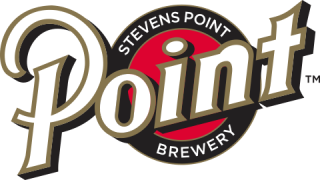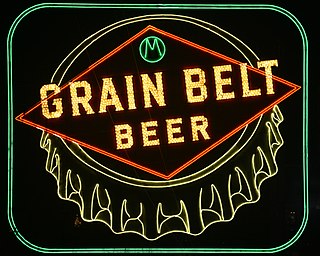Related Research Articles

Craft beer is a beer that has been made by craft breweries, which typically produce smaller amounts of beer, than larger "macro" breweries, and are often independently owned. Such breweries are generally perceived and marketed as emphasising enthusiasm, new flavours, and varied brewing techniques.

Stevens Point Brewery is a regional American brewery located in Stevens Point, Wisconsin. The brewery is the fifth-oldest continuously operating brewery and the third-oldest privately owned brewery in the nation.

Bass Brewery was founded in 1777 by William Bass in Burton-upon-Trent, Staffordshire, England. The main brand was Bass Pale Ale, once the highest-selling beer in the UK. By 1877, Bass had become the largest brewery in the world, with an annual output of one million barrels. Its pale ale was exported throughout the British Empire, and the company's red triangle became the UK's first registered trade mark.

Grain Belt is a brand of beer brewed in the American state of Minnesota, by the August Schell Brewing Company. The beer has been produced in a number of varieties. Grain Belt Golden was the original style introduced in 1893. The current offerings are: Grain Belt Premium, first introduced in 1947; Grain Belt Premium Light; Grain Belt Nordeast, introduced on April 7, 2010; and the newest offering, Grain Belt Lock & Dam, introduced in 2016. It was originally produced by the Minneapolis Brewing Company which formed with the merger of four smaller brewers in 1891. Soon after introduction, Grain Belt became the company's flagship product. It was brewed at the original Grain Belt brewery in Minneapolis, Minnesota until 1976. A series of other owners followed, and Schell took over the product line in 2002.

Genesee Brewing Company is an American brewery located along the Genesee River in Rochester, New York. From 2000 to 2009, the company was known as the High Falls Brewing Company. In 2009, High Falls was acquired by the capital investment firm KPS Capital. Together with newly acquired Labatt USA, KPS merged the two companies as North American Breweries. Along with this change, High Falls Brewery changed its name back to the original "Genesee Brewing Company" operating under the North American Breweries name. In October 2012, North American Breweries was purchased by FIFCO.

Stone Brewing is a brewery headquartered in Escondido, California, USA. Founded in 1996 in San Marcos, California, it is the largest brewery in Southern California. Based on 2020 sales volume it is the ninth largest craft brewery in the United States.
The Matilda Bay Brewing Company was a West Australian brewery. It was the first new brewery opened in Australia since World War II and Australia's first craft brewery. Originating from small batches brewed for the Sail and Anchor Hotel in 1984, their main brewery opened in 1989 in a prominent building on the Stirling Highway occupied by Ford Motor Company. The company was purchased by Carlton & United Breweries in the early 1990s.

Beer in the United Kingdom has a long history, and has quite distinct traditions. Historically the main styles were top-fermented Bitters, Porters, Stouts and Milds, but after World War II lagers took over half the market by volume. The Campaign for Real Ale (CAMRA) was founded in 1971 and has encouraged the preservation and revival of traditional styles of ale. In particular CAMRA has promoted cask conditioned beer, which completes its maturation in casks in the cellar of the pub rather than at the brewery. As of 2014 the UK drank 634 million imperial pints of cask ale, representing 60% of ale in pubs and restaurants and 17% of all beer in pubs. In total 42.42 million hectolitres of beer were produced in 2013 of which 48% was sold in the off-trade.
Saratoga Springs, Nebraska Territory, or Saratoga, was a boom and bust town founded in 1856 that thrived for several years. During its short period of influence the town grew quickly, outpacing other local settlements in the area including Omaha and Florence, and briefly considered as a candidate for the Nebraska Territorial capitol. Saratoga was annexed into Omaha in 1887, and has been regarded a neighborhood in North Omaha since then.
The Metz Brothers Brewing Company was among the first brewers in the U.S. state of Nebraska, having been established in the city of Omaha in 1859. It was among the earliest manufacturers in the city. After originally opening as the McCumbe Brewery, the facility was sold several times until brothers Frederick and Philip Metz purchased it in 1861. Metz was one of the "Big 4" brewers located in Omaha, which also included the Krug, Willow Springs and Storz breweries.

Gottlieb Storz (1852–1939) was a pioneer entrepreneur in Omaha, Nebraska. Born in Benningen, Wurttemberg, Storz was the founder of the Storz Brewery. He was an important member of Omaha's German immigrant community, and an important businessman in Omaha history. Storz was regarded as a "giant in the brewing world".
Willow Springs Distilling Company was a brewery located in South Omaha, Nebraska. Part of a national conglomerate, Willow Springs was Nebraska's first distillery, and grew to become the nation’s third largest distillery before the Great Depression. Willow Springs was one of the "Big 4" brewers located in Omaha, which also included the Krug, Storz and Metz breweries.
The Fred Krug Brewery was located at 2435 Deer Park Boulevard in Omaha, Nebraska. Founded in 1859, Krug Brewery was the first brewery in the city. Krug was one of the "Big 4" brewers located in Omaha, which also included the Storz, Willow Springs and Metz breweries. Later sold to Falstaff in 1936, the facility closed in 1987.

The beers of the Caribbean are unique to each island in the region, although many are variants of the same style. Each island generally brews its own unique pale lager, the occasional stout, and often a non-alcoholic malta beverage. Contract-brewing of international beers is also common, with Heineken Pilsener and Guinness Foreign Extra Stout being the most popular. The beers vary between the islands to suit the taste and the brewing method used.

The Falstaff Brewing Corporation was an American brewery located in St. Louis, Missouri. With roots in the 1838 Lemp Brewery of St. Louis, the company was renamed after the Shakespearean character Sir John Falstaff in 1903. Production peaked in 1965 with 7,010,218 barrels brewed and then dropped 70 percent in the next 10 years. While its smaller labels linger on today, its main label Falstaff Beer went out of production in 2005. The rights to the brand are owned by Pabst Brewing Company.

The Gottlieb Storz House is located in the Blackstone neighborhood of Midtown Omaha, Nebraska. Built in 1905 by Omaha beer magnate Gottlieb Storz, the mansion was designated an Omaha Landmark on December 21, 1982, and was listed in the National Register of Historic Places on August 7, 1974. It was included in the Gold Coast Historic District when the district was listed in the NRHP on March 14, 1997.

Shmaltz Brewing Company is an American craft brewing company headquartered in Troy, New York. Originally primarily known for its He'Brew flagship brand, the company produces a large line of Shmaltz Brewing beers and numerous other brands including 518/838 craft beers and the Alphabet City Brewing brand. It also produced Coney Island Craft Lagers until that brand's acquisition by Boston Beer Company in 2013.

San Diego County, California, has been called "the Craft Beer Capital of America". As of 2018, the county was home to 155 licensed craft breweries – the most of any county in the United States. Based on 2016 sales volume, three San Diego County breweries – Stone, Green Flash, and Karl Strauss – rank among the 50 largest craft brewers in the United States. San Diego County brewers pioneered the specialty beer style known as Double India Pale Ale, sometimes called San Diego Pale Ale. Its beer culture is a draw for tourism, particularly during major festivals such as San Diego Beer Week and the San Diego International Beer Competition. San Diego County breweries including Stone Brewing Co., AleSmith Brewing Company and Ballast Point Brewing Company are consistently rated among the top breweries in the world.

The Jacob Schmidt Brewing Company is a former brewing company that was located at 882 W. Seventh Street in Saint Paul, Minnesota. Founded in 1855, the brewery was originally known as the Christopher Stahlmann Cave Brewery.
References
- ↑ Larsen, L.C. and Cotrell, B.J. (1997) The Gate City: A History of Omaha. University of Nebraska Press. p 144.
- ↑ "History of Omaha," Andreas' History of Nebraska - Douglas County. Retrieved 9/8/07.
- ↑ (1888) "City of Omaha." Andreas' History of Nebraska. Retrieved 9/3/07.
- ↑ "Breweries." [usurped] Nebraska State Historical Society. Retrieved 9/7/07.
- ↑ Burbach, C. (2009) "Arthur C. Storz Jr. dead at 89", Omaha World-Herald. Retrieved 11/14/10.
- ↑ "Storz Brewery" Archived 2007-07-08 at the Wayback Machine . Omaha Public Library. Retrieved 9/7/07.
- ↑ "Storz: Can of the month." Retrieved 9/7/07.
- ↑ Barnhart, T.F. (1952) Weekly Newspaper Management. Appleton-Century-Crofts. p 190.
- ↑ "Storz: Can of the month." Retrieved 9/7/07.
- ↑ Bednarek , J.R.D. (2002) The Changing Image of the City: Planning for Downtown Omaha, 1945-1973. University of Nebraska Press. p 123.
- ↑ Albers, H.H. (1974) Principles of Management: A Modern Approach. Wiley Publishers. p 366.
- ↑ Gausephol, D. (2001) "Your Dad’s Beer: Sipping a Generation," Beer Magazine. 22(3). Retrieved 9/7/07.
- ↑ "Trays by Brewery". Retrieved 9/8/07.